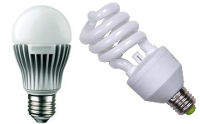 I’ve been in the electrical wholesale business for almost 30 years and every day I sell light bulbs. For over 30 years lamps basically got better, offering more light output per watt on the newer lamps. But recently somebody started taking my light bulbs away. What am I going to do? What are all the old people going to use to read their papers?
I’ve been in the electrical wholesale business for almost 30 years and every day I sell light bulbs. For over 30 years lamps basically got better, offering more light output per watt on the newer lamps. But recently somebody started taking my light bulbs away. What am I going to do? What are all the old people going to use to read their papers?
Younger people tend to understand this, while other people tend to get upset that the government is getting involved in something as simple as light bulbs. Most people don’t even know it’s happening. So now I let out the secret.
GENERAL SERVICE INCANDESCENT LAMPS
|
Rated Lumen Ranges |
Maximum Rate Wattage |
Minimum Rate Lifetime |
Effective Date |
| 1490-2600 | 72 | 1,000 hrs | 1/1/2012 |
| 1050-1489 | 53 | 1,000 hrs | 1/1/2013 |
| 750-1049 | 43 | 1,000 hrs | 1/1/2014 |
| 310-749 | 29 | 1,000 hrs | 1/1/2014 |
What does this mean? On January 1st 2012, 100 watt light bulbs went bye bye. Well not really. On January 1st 2012 light bulb manufacturers could no longer make 100 watt A style lamps (table lamps) for sale in the US. Then on January 1st 2013, 75 watt A style lamps are no longer made. January 1st 2014, 60 and 40 watt go the same way. All these lamps are available until stock is depleted.
Now, why are they doing this? After reading and reading and talking to factory reps and some energy specialists, it has to do with building power plants. The more wattage and kilo-watts saved, the less power used. DUH. If energy is saved on a large scale, then enough energy would be saved to avoid building a power plant. In this age of “not in my backyard”, the legal fees would probably be as high as the cost of building the plant.
Once all the incandescent bulbs are gone, you’ll have to choose between LED and CFL.
Which to use, LED or CFL
Which is better, Compact Fluorescents (CFLs) or LEDs? I’m not the greenest person in the world and normally don’t go out of my way to be green, other than recycling trash.
Compact fluorescent
At one time legislation was going to cost you big time bucks if fluorescents, including CFLs, were broken. It was considered a “hazardous spill” and you had to open your windows; if you cleaned it up yourself you would not be able to use a vacuum or broom, only a sticky tape to clean it up. A professional team did this for a woman in Maine and after everything was done it cost her $3000.00 and insurance did not cover it. Now, it’s still not a good idea to use a vacuum because of the mercury.
Now all fluorescents are required to be recycled. Smaller recycle boxes can cost you as much as $1.50 a lamp to dispose. Some waste companies offer to be open on certain days and be available for you to bring the lamps to them. Today, with this legislation, nobody ever throws their light bulbs away (wink wink).
Light-emitting diode
LEDs are not cheap, but they are coming down in price. Right now the biggest change in LEDs is the lumens per watt, or the amount of light coming out divided by the wattage used. While the wattage on some lamps has not gone up, the light output has. It was just 2 years ago when the LED manufacturers started making lamps equal to a 75R30 (65BR30), which is the most popular residential light at the moment. Prices are starting to come down on older technology LEDs, and more and more stores are stocking them. LEDs contain no mercury, making them easy to dispose of, and no special handling, other than throwing them in the recycle bin. The energy saving is ridiculous! I just changed out 7 – 50 watt MR16 lamps with 7 – 6.2 watt dimmable lamps. That right there is a 87% energy savings, and it cuts out going up and down a ladder 56 times to change the lamps (7 lamps, 8 times). In this case, CFLs were not an option.
Now the negative about LEDs. When they first started becoming a reality in residential lighting they were advertised at 50,000 hours lamp life. Lawsuits happened, causing the big names in LEDs to start advertising 25,000 to 30,000 hours, with some lamps still rated at 50,000 hours. LEDs lose lumens over time, just like incandescent and CFLs, but LEDs lose more than 3 times that of a CFL: 29% to 9%.

So which should I use?
If you need beam control, LED has different beam spreads available, like floods, narrow floods, and spots. CFLs have none. LED and CFL fit medium sockets, like table lamps, but while some LED manufacturers do make LEDs to fit in fluorescent sockets, the price for residential use is almost prohibitive. If you have $3 you can buy a name brand CFL; if you have $25 you can buy some LEDs. Imports in each kind are cheaper. Just remember, whichever you choose, it is an investment, but there is most definitely a payback.Filed under Electrical
Tagged: CFL, Electrical, LED, light bulbs



Which type is better for dimmers? My understanding is that you can’t use regular CFLs with a dimmer switch, and even CFLs specially designed for dimmer switches do not work great.
CFL’s have to say dimmable on the lamp or carton, and some CFL makers will say a standard dimmer will work. LEDs are the same. They have to say that they are dimmable and some will say you can dim with any dimmer. Some dimmer manufacturers are making dimmers for LEDs and CFLs which have an adjustment wheel on the dimmer to ‘fine tune’ the dimmer. If you want to just dim your lights these will work but for now, neither dim as well as an incandescent.
If one is replacing a traditional 100w bulb with a CFL or LED, can I put in anything that fits and takes less power than the original fixture supports?
For example, replacing a 100w A19 incandescent bulb, claimed as 1260 lumens, can I put in a 42w CFL which claims 2600 lumens? Or must I go with a “100w replacement bulb,” such as a 23w CFL (1600 lumens)?
While I’m not a real expert I would say from my personal use the using 42 watt CFL’s in a 75 watt rated downlight can has never been a problem for me. It’s never kicked the thermal protection on the can and turned it off. While a watt is a watt is a watt, you still have other electronics that can be kicking up a little wattage also, but not that much. You are still creating over 50% less heat with the CFL.
The power ratings on fixtures are for actual wattage (current/heat/etc flow), so yes, you can put in anything that takes less wattage. Of course, putting in something that just takes a little bit less wattage will negate a lot of the wattage savings of CFLs (as well as providing a whole lot more light)
Thanks Aaron! Great comment!
I haven’t looked lately: do they make three-way bulbs in either CFL or LED? I know that if you put a regular CFL bulb in a 3-way-switch lamp (e.g. the switch goes off-25W-50W-75W-off), it will generally come on after two clicks, and turn off after two more clicks, even though technically even the lowest wattage of the lamp way exceeds what the bulb theoretically needs. Does it shorten the life of a regular (one-way) CFL bulb to be used this way?
I know that 3-way CFLs are made, I have three in my house right now, and I’m working under one of them right now. As for shortening the lamp life on a CFL by using them, I do not think it will hurt a standard CFL if you use it in a 3-way socket but I’ve never been told either way, good or bad. If you look at the base on a 3-way lamp you will see 2 pieces of metal (not including the screw in base part of the lamp) An incandescent would hit one of these for 25 watt, the other for 50 watt and then both for 75 watt.
I ordered a three-way desk lamp for my daughter. It arrived today and I noticed that it wasn’t a three-way switch. Hours on the phone got me to a manager who explained that some CA law meant they had to swap out the three-way socket for a regular socket. I’ll have to replace the socket myself, or pay someone to do it, ON A BRAND-NEW LAMP. I am not happy. What is this, North Korea? Dumbest legislation I’ve ever heard of.